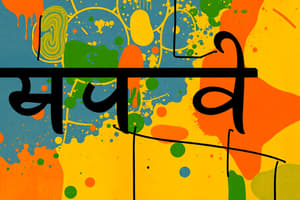Podcast
Questions and Answers
Which script is used to write Hindi?
Which script is used to write Hindi?
- Roman
- Devanagari (correct)
- Cyrillic
- Hangul
What is the primary function of English as a language?
What is the primary function of English as a language?
- To function as a lingua franca. (correct)
- To provide a simplified vocabulary.
- To act as a classical language.
- To serve as a sacred language.
Sanskrit is considered the foundation for many modern languages of which region?
Sanskrit is considered the foundation for many modern languages of which region?
- South Asia (correct)
- Southeast Asia
- Central Asia
- East Asia
What method is fundamental to scientific inquiry?
What method is fundamental to scientific inquiry?
Which aspect is NOT typically studied in social sciences?
Which aspect is NOT typically studied in social sciences?
What is a significant impact of scientific advancements?
What is a significant impact of scientific advancements?
Which language is primarily considered the classical language of Hinduism?
Which language is primarily considered the classical language of Hinduism?
Hindi is spoken primarily in which region of India?
Hindi is spoken primarily in which region of India?
Flashcards
What is Hindi?
What is Hindi?
Hindi is an Indo-Aryan language spoken primarily in North India and parts of other regions of India. It is the official language of India, along with English, and one of the two most widely spoken languages in India. It is written using the Devanagari script and its vocabulary has significant influence from Sanskrit. Hindi is used extensively in literature, media, and daily communication.
What is English?
What is English?
English is a West Germanic language that evolved from the Anglo-Frisian dialects brought to Britain by the Angles, Saxons, and Jutes. It is the official language of many countries globally and serves as a lingua franca, facilitating communication between people from various linguistic backgrounds. English is widely used in science, technology, and commerce, across numerous disciplines and forms a significant part of global communication.
What is Sanskrit?
What is Sanskrit?
Sanskrit is an ancient Indo-European language of India, considered the classical language of Hinduism, Jainism, and Buddhism. It is the foundation for many modern Indian languages and known for its highly structured grammar. Sanskrit is considered a sacred language in Hinduism, and has served as a linguistic source for other languages in South Asia.
What is science?
What is science?
Signup and view all the flashcards
What are the social sciences?
What are the social sciences?
Signup and view all the flashcards
Study Notes
Hindi
- Hindi is an Indo-Aryan language spoken primarily in North India and parts of other regions of India.
- It is the official language of India, along with English.
- It is one of the two most widely spoken languages of India, after English.
- It is written using the Devanagari script.
- Its vocabulary has significant influence from Sanskrit.
- It has a rich literary tradition, including poetry, prose, and drama.
- Hindi is used extensively in literature, media, and daily communication.
English
- English is a West Germanic language that evolved from the Anglo-Frisian dialects brought to Britain by the Angles, Saxons, and Jutes.
- It is the official language of many countries globally.
- It serves as a lingua franca, facilitating communication between people from various linguistic backgrounds.
- It possesses a diverse range of vocabulary and complex grammar.
- It is widely used in science, technology, and commerce.
- Its usage is pervasive across numerous disciplines and forms significant part of global communication.
Sanskrit
- Sanskrit is an ancient Indo-European language of India.
- It is the classical language of Hinduism, Jainism, and Buddhism.
- It is the foundation for many modern Indian languages.
- It is considered a sacred language in Hinduism.
- It is known for its highly structured grammar.
- It is an important language in Indian culture and philosophy.
- It has served as a linguistic source for other languages in South Asia.
Science
- Science is a systematic enterprise that builds and organizes knowledge in the form of testable explanations and predictions about the universe.
- It relies on empirical evidence and rigorous testing to validate theories.
- It involves various branches, encompassing physical sciences, biological sciences, and others.
- Key tools of science include observation, experimentation, and data analysis.
- Scientific method involves formulating hypotheses, conducting experiments, and analyzing results.
- Scientific advancements have profoundly altered human lives and understanding of the universe.
- Science is a critical aspect of societal progress, leading to innovations and solutions across multiple sectors.
Social Science (s.science)
- Social sciences study human behavior and societies.
- They explore various aspects of human interaction, including economics, sociology, political science, and psychology.
- Social sciences employ diverse methodological approaches to understand and interpret human actions in groups and organizations.
- They differ from natural sciences in their focus on human behavior and societal structures.
- They frequently utilize qualitative and quantitative data to analyze social phenomena.
- Social sciences aim to understand and explain the complexities of human social life.
- They address challenges like social inequalities, political conflicts, and economic development.
Studying That Suits You
Use AI to generate personalized quizzes and flashcards to suit your learning preferences.
Description
Explore the rich diversity of languages in India, focusing on Hindi, its origins, and literary significance. Additionally, delve into the evolution and global influence of the English language, examining its role in various fields and as a lingua franca.




